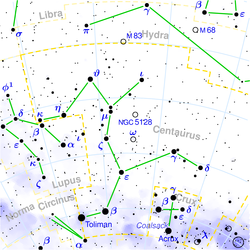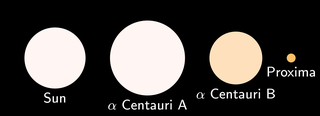Proxima Centauri
2008/9 Schools Wikipedia Selection. Related subjects: Space (Astronomy)
| Observation data Epoch J2000 Equinox J2000 |
|
|---|---|
| Constellation ( pronunciation) |
Centaurus |
| Right ascension | 14h 29m 42.9487s |
| Declination | −62° 40′ 46.141″ |
| Apparent magnitude (V) | 11.05 |
| Characteristics | |
| Spectral type | M5.5 Ve |
| U-B colour index | 1.49 |
| B-V colour index | 1.90 |
| Variable type | Flare star |
| Astrometry | |
| Radial velocity (Rv) | −20.3 km/s |
| Proper motion (μ) | RA: -3775.64 mas/ yr Dec.: 768.16 mas/ yr |
| Parallax (π) | 771.99 ± 2.25 mas |
| Distance | 4.22 ± 0.01 ly (1.295 ± 0.004 pc) |
| Absolute magnitude (MV) | 15.49 |
| Details | |
| Mass | 0.123 M☉ |
| Radius | 0.145 R☉ |
| Luminosity | 1.38 × 10−4 L☉ |
| Temperature | 3,040 K |
| Metallicity | 10% |
| Rotation | 83.5 days |
| Age | 4.85 × 109 years |
| Other designations | |
|
α Centauri C, V645 Centauri, GCTP 3278.00, GJ 551, LHS 49, LFT 1110, LTT 5721, HIP 70890.
|
|
Proxima Centauri (Latin proximus, -a, -um: meaning 'next to' or 'nearest to') is a red dwarf star that is likely a part of the Alpha Centauri star system and is the nearest star to the Sun at a distance of 4.22 light-years. As the name suggests, it is located in the constellation of Centaurus.
Proxima Centauri is categorized as a flare star, as it undergoes random increases in luminosity because of magnetic activity. It only has about an eighth of the Sun's mass, and consequently it has a very low luminosity. Because of its proximity, the size of this star can be measured directly, giving a diameter only one-seventh the size of the Sun.
Observation history
Proxima Centauri was discovered to share the same proper motion as Alpha Centauri in 1915 by Robert Innes while he was Director of the Union Observatory in Johannesburg, South Africa. Innes also suggested the name Proxima Centauri for the star. In 1917 at the Royal Observatory at the Cape of Good Hope, the Dutch astronomer J. Voûte measured the trigonometric parallax and determined that Proxima Centauri was indeed the same distance from the Sun as Alpha Centauri and hence was also the lowest luminosity star known at the time.
In 1951, Harlow Shapley announced that Proxima Centauri was a flare star. Examination of past photographic records showed that the star displayed a measureable increase in magnitude about 8% of the time, making it the most active flare star then discovered.
Characteristics
Red dwarfs in general are far too faint to be observable with the naked eye, and Proxima Centauri is no exception. It has an apparent magnitude of 11 while its absolute magnitude is a very dim 15.5. Even from Alpha Centauri A or B, Proxima would only be seen as a 5th magnitude star. If the Sun were to become as dim as Proxima, all of the planets except Venus would be too faint to be seen with the naked eye, and even Venus at its brightest would be a barely visible 6th magnitude.
Based on the parallax of 772.3 ± 2.4 milliarcseconds measured by Hipparcos (and the more precise parallax determined using the Fine Guidance Sensors on the Hubble Space Telescope of 768.7 ± 0.3 milliarcseconds), Proxima Centauri is roughly 4.2 light years from Earth, or 270,000 times more distant than the Sun. Its closest neighbors are Alpha Centauri A and B (at 0.21 light years), the Sun, and Barnard's Star (at 6.6 light years). From Earth's vantage point, Proxima is separated by 2.2° from Alpha Centauri, or 4 times the angular diameter of the full Moon.
At least among the known stars, Proxima Centauri has been the closest star to the Sun for about the last 32,000 years and will be so for about another 9,000 years, when it will be replaced by Barnard's Star. Proxima Centauri has a relatively large proper motion—moving 3.85 arcseconds per year across the sky.
In 2002, VLTI used optical interferometry to measure an angular diameter of 1.02 ± 0.08 milliarcsec for Proxima Centauri. Because its distance is known, the actual diameter of Proxima Centauri can be calculated to be about 1/7 that of the Sun, or 1.5 times that of Jupiter.
Because of its low mass, the interior of the star is completely convective, which means that energy is transferred to the exterior by the physical movement of plasma (rather than through radiative processes). Convection is associated with the generation and storage of a magnetic field. The magnetic energy from this field is released at the surface through stellar flares that briefly increase the overall luminosity of the star. These flares are hot enough to radiate X-rays, and indeed the quiescent X-ray luminosity of this star is roughly equal to that of the much larger Sun. However, the overall activity level of this star is considered relatively low compared to other M-class dwarfs. This activity appears to vary with a period of roughly 442 days.
| Orbital period (days) |
Separation (A.U.) |
Maximum Mass (× Jupiter) |
|---|---|---|
| 50 | 0.13 | 3.7 |
| 600 | 0.69 | 8.3 |
| 3000 | 1.00 | 22 |
Search for planets
Proxima Centauri, along with Alpha Centauri A and B, are among the "Tier 1" target stars for NASA's proposed Space Interferometry Mission (SIM). Theoretically, SIM will be able to detect planets as small as three Earth-masses within two Astronomical Units of a "Tier 1" target. Should a massive planet orbit Proxima Centauri, some displacement of the star would be expected to occur over the course of each orbit. If this orbital plane is inclined toward the line of sight from the Earth then this displacement would cause changes in the radial velocity of Proxima Centauri. However no such shifts have yet been observed despite multiple radial velocity measurements. This puts significant constraints on the maximum mass that such a companion could possess.
Possibility of life
The TV documentary Alien Worlds hypothesizes that a life-sustaining planet could theoretically exist orbiting Proxima Centauri or other Red Dwarf stars. Such a planet would have to be as little as 0.032 AU away from Proxima Centauri, and would have a year lasting just 6.3 days. Since Proxima Centauri is a flare star this could cause difficulties though the scientists thought these difficulties could be overcome, see Continued theories. Flares could destroy the atmosphere of any planet in the Habitable zone. Other scientists disagree that Red Dwarf stars could sustain life. See Rare Earth hypothesis.
For a more complete discussion see Habitability of red dwarf systems.
The Alpha Centauri system
From the time of the discovery of Proxima, it was suggested that it was likely to be a true companion of the Alpha Centauri double star system. At a distance to Alpha Centauri of just 0.21 ly (15,000 ± 700 AU), Proxima Centauri may be in orbit about Alpha, with an orbital period on the order of 500,000 years or more. For this reason, Proxima is sometimes referred to as Alpha Centauri C. Modern estimates, taking into account the small separation between and relative velocity of the stars, suggest that the chance of the observed alignment being a coincidence is roughly one in a million.
The most recent observational work combined data from the Hipparcos satellite with ground-based observations and concluded that the data was consistent with the hypothesis that the three stars are truly a bound system. If so, Proxima would currently be near apastron (the furthest point in its orbit from the Alpha Centauri system). More accurate measurement of the radial velocity would be needed to confirm this conclusion.
Interstellar travel
Proxima Centauri has been suggested as a logical first destination for interstellar travel, although as a flare star it would not be particularly hospitable. However, even at the fastest speed currently attained by a manned vehicle the journey to Proxima Centauri would take ~32,000 years. Project Longshot could theoretically reach the Alpha Centauri system in about 100 years.

